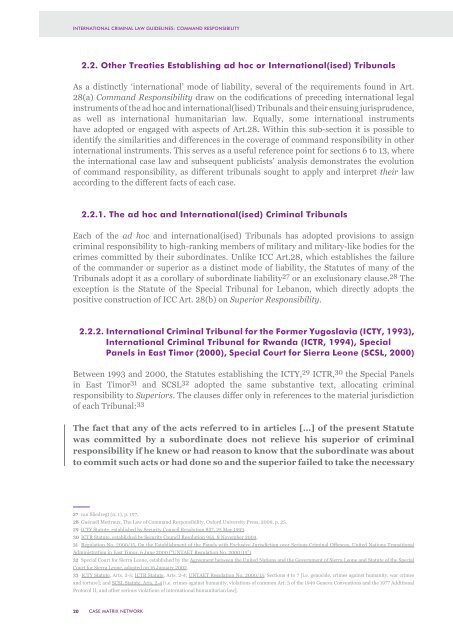Command Responsibility
CMN_ICL_Guidelines_Command_Responsibility_En
CMN_ICL_Guidelines_Command_Responsibility_En
You also want an ePaper? Increase the reach of your titles
YUMPU automatically turns print PDFs into web optimized ePapers that Google loves.
INTERNATIONAL CRIMINAL LAW GUIDELINES: COMMAND RESPONSIBILITY<br />
2.2. Other Treaties Establishing ad hoc or International(ised) Tribunals<br />
As a distinctly ‘international’ mode of liability, several of the requirements found in Art.<br />
28(a) <strong>Command</strong> <strong>Responsibility</strong> draw on the codifications of preceding international legal<br />
instruments of the ad hoc and international(lised) Tribunals and their ensuing jurisprudence,<br />
as well as international humanitarian law. Equally, some international instruments<br />
have adopted or engaged with aspects of Art.28. Within this sub-section it is possible to<br />
identify the similarities and differences in the coverage of command responsibility in other<br />
international instruments. This serves as a useful reference point for sections 6 to 13, where<br />
the international case law and subsequent publicists’ analysis demonstrates the evolution<br />
of command responsibility, as different tribunals sought to apply and interpret their law<br />
according to the different facts of each case.<br />
2.2.1. The ad hoc and International(ised) Criminal Tribunals<br />
Each of the ad hoc and international(ised) Tribunals has adopted provisions to assign<br />
criminal responsibility to high-ranking members of military and military-like bodies for the<br />
crimes committed by their subordinates. Unlike ICC Art.28, which establishes the failure<br />
of the commander or superior as a distinct mode of liability, the Statutes of many of the<br />
Tribunals adopt it as a corollary of subordinate liability 27 or an exclusionary clause. 28 The<br />
exception is the Statute of the Special Tribunal for Lebanon, which directly adopts the<br />
positive construction of ICC Art. 28(b) on Superior <strong>Responsibility</strong>.<br />
2.2.2. International Criminal Tribunal for the Former Yugoslavia (ICTY, 1993),<br />
International Criminal Tribunal for Rwanda (ICTR, 1994), Special<br />
Panels in East Timor (2000), Special Court for Sierra Leone (SCSL, 2000)<br />
Between 1993 and 2000, the Statutes establishing the ICTY, 29 ICTR, 30 the Special Panels<br />
in East Timor 31 and SCSL 32 adopted the same substantive text, allocating criminal<br />
responsibility to Superiors. The clauses differ only in references to the material jurisdiction<br />
of each Tribunal: 33<br />
The fact that any of the acts referred to in articles […] of the present Statute<br />
was committed by a subordinate does not relieve his superior of criminal<br />
responsibility if he knew or had reason to know that the subordinate was about<br />
to commit such acts or had done so and the superior failed to take the necessary<br />
27 van Sliedregt (n. 1), p. 197.<br />
28 Guénaël Mettraux, The Law of <strong>Command</strong> <strong>Responsibility</strong>, Oxford University Press, 2009, p. 25.<br />
29 ICTY Statute, established by Security Council Resolution 827, 25 May 1993.<br />
30 ICTR Statute, established by Security Council Resolution 955, 8 November 2004.<br />
31 Regulation No. 2000/15, On the Establishment of the Panels with Exclusive Jurisdiction over Serious Criminal Offences, United Nations Transitional<br />
Administration in East Timor, 6 June 2000 (“UNTAET Regulation No. 2000/15”).<br />
32 Special Court for Sierra Leone, established by the Agreement between the United Nations and the Government of Sierra Leone and Statute of the Special<br />
Court for Sierra Leone, adopted on 16 January 2002.<br />
33 ICTY Statute, Arts. 2-5; ICTR Statute, Arts. 2-4; UNTAET Regulation No. 2000/15, Sections 4 to 7 [i.e. genocide, crimes against humanity, war crimes<br />
and torture]; and SCSL Statute, Arts. 2-4 [i.e. crimes against humanity, violations of common Art. 3 of the 1949 Geneva Conventions and the 1977 Additional<br />
Protocol II, and other serious violations of international humanitarian law].<br />
20<br />
CASE MATRIX NETWORK


